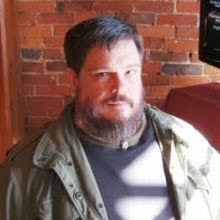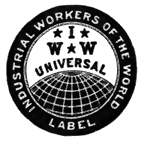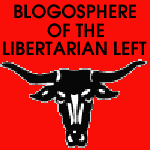It's the Soldier Who Gives You the Right to Protest, and Other Horse Shit
A couple of items from yesterday's Progressive Review. First, a quote from Frank Church:
So to the idiots who challenge us to "show one instance" where our liberties have been infringed by counter-terrorism legislation, I respond that the very existence of such government capabilities is an infringement of our liberties. The very existence of such capabilities means that our liberties at any given moment are held only as a grant of privilege from the government, and could be taken away at any time. Our liberties are no longer something we're in a position to force the government to recognize, but require an ongoing grant of government permission for their exercise. The full administrative, legal, and physical infrastructure for dictatorship already exists, and could be put into full-scale operation by a presidential stroke of the pen. (That's leaving out the fact that we'll never know whether some government powers like library snooping and "sneak and peak" searches have been abused, since it's actually illegal to report incidents of abuse. That's right--it's illegal for us, the supposedly sovereign public, to inform each other about what "our" government is doing.)
How real is the danger of such a presidential declaration? Decide for yourself:
Several months ago I wrote a post ("Fighting the Domestic Enemy: You") detailing the history of martial law plans, the militarization of local police forces under drug war pretenses, and the selective application of martial law plans and infrastructure for countering anti-globalization protests.
For more background on U.S. martial law plans going back to Garden Plot, check out this article by Frank Morales: "U.S. Military and Civil Disturbance Planning: The War at Home"
For background on Ollie North's and Louis Giuffrida's martial law planning, here's an excerpt from the original text of the Miami Herald story on it from July 5, 1987:
[The capability of the NSA] any time could be turned around on the American people, and no American would have any privacy left, such is the capability to monitor everything: telephone conversations, telegrams, it doesn't matter. There would be no place to hide. . . . There would be no way to fight back because the most careful effort to combine together in resistance to the government, no matter how privately it was done, is within the reach of the government to know.
I don't want to see this country ever go across the bridge. I know the capacity that is there to make tyranny total in America, and we must see to it that this agency [the National Security Agency] and all agencies that possess this technology operate within the law and under proper supervision, so that we never cross over that abyss. That is the abyss from which there is no return. - Senator Frank Church (D-Idaho), investigating the National Security Agency, 1975, quoted by Nat Hentoff in the Village Voice
So to the idiots who challenge us to "show one instance" where our liberties have been infringed by counter-terrorism legislation, I respond that the very existence of such government capabilities is an infringement of our liberties. The very existence of such capabilities means that our liberties at any given moment are held only as a grant of privilege from the government, and could be taken away at any time. Our liberties are no longer something we're in a position to force the government to recognize, but require an ongoing grant of government permission for their exercise. The full administrative, legal, and physical infrastructure for dictatorship already exists, and could be put into full-scale operation by a presidential stroke of the pen. (That's leaving out the fact that we'll never know whether some government powers like library snooping and "sneak and peak" searches have been abused, since it's actually illegal to report incidents of abuse. That's right--it's illegal for us, the supposedly sovereign public, to inform each other about what "our" government is doing.)
How real is the danger of such a presidential declaration? Decide for yourself:
DOUG THOMPSON: BUSH READY TO DECLARE MARTIAL LAW
Doug Thompson, Capitol Hill Blue - President George W. Bush has signed executive orders giving him sole authority to impose martial law, suspend habeas corpus and ignore the Posse Comitatus Act that prohibits deployment of U.S. troops on American streets. This would give him absolute dictatorial power over the government with no checks and balances.
Bush discussed imposing martial law on American streets in the aftermath of the 9/11 terrorist attacks by activating “national security initiatives” put in place by Ronald Reagan during the 1980s.
These “national security initiatives," hatched in 1982 by controversial Marine Colonel Oliver North, later one of the key players in the Iran-Contra Scandal, charged the Federal Emergency Management Agency with administering executive orders that allowed suspension of the Constitution, implementation of martial law, establishment of internment camps, and the turning the government over to the President.
John Brinkerhoff, deputy director of FEMA, developed the martial law implementation plan, following a template originally developed by former FEMA director Louis Guiffrida to battle a “national uprising of black militants.” Giuffrida’s implementation of martial law called for jailing at least 21 million African Americans in “relocation camps.” Brinkerhoff later admitted in an interview with the Miami Herald that President Reagan signed off on the initiatives and they remained in place, dormant, until George W. Bush took office.
Brinkerhoff moved on the Anser Institute for Homeland Security and, following the 9/11 terrorist attacks, provided the Bush White House and the Pentagon with talking points supporting revised “national security initiatives” that would could allow imposition of martial law and suspension of the Posse Comitatus Act of 1878, the law that is supposed to forbid use of troops for domestic law enforcement.
Brinkerhoff wrote that intentions of Posse Comitatus are “misunderstood and misapplied” and that the U.S. has in times of national emergency the “full and absolute authority” to send troops into American streets to “enforce order and maintain the peace.”
Bush used parts of the plan to send troops into the streets of New Orleans following Hurricane Katrina. In addition, FEMA hired former special forces personnel from the mercenary firm Blackwater USA to “enforce security.”. . .
Several months ago I wrote a post ("Fighting the Domestic Enemy: You") detailing the history of martial law plans, the militarization of local police forces under drug war pretenses, and the selective application of martial law plans and infrastructure for countering anti-globalization protests.
For more background on U.S. martial law plans going back to Garden Plot, check out this article by Frank Morales: "U.S. Military and Civil Disturbance Planning: The War at Home"
At first, the Garden Plot exercises focused primarily on racial conflict. But beginning in 1970, the scenarios took a different twist. The joint teams, made up of cops, soldiers and spies, began practicing battle with large groups of protesters. California, under the leadership of Ronald Reagan, was among the most enthusiastic participants in Garden Plot war games.
...Garden plot [subsequently] evolved into a series of annual training exercises based on contingency plans to undercut riots and demonstrations, ultimately developed for every major city in the United States. Participants in the exercises included key officials from all law enforcement agencies in the nation, as well as the National Guard, the military, and representatives of the intelligence community. According to the plan, joint teams would react to a variety of scenarios based on information gathered through political espionage and informants. The object was to quell urban unrest. (originally published in Covert Action Quarterly, Spring-Summer 2000)
For background on Ollie North's and Louis Giuffrida's martial law planning, here's an excerpt from the original text of the Miami Herald story on it from July 5, 1987:
REAGAN AIDES AND THE 'SECRET' GOVERNMENT
by ALFONSO CHARDY, HERALD WASHINGTON BUREAU
WASHINGTON -- Some of President Reagan's top advisers have operated a virtual parallel government outside the traditional Cabinet departments and agencies almost from the day Reagan took office, congressional investigators and administration officials have concluded.
Investigators believe that the advisers' activities extended well beyond the secret arms sales to Iran and aid to the contras now under investigation.
Lt. Col. Oliver North, for example, helped draw up a controversial plan to suspend the Constitution in the event of a national crisis, such as nuclear war, violent and widespread internal dissent or national opposition to a U.S. military invasion abroad.
When the attorney general at the time, William French Smith, learned of the proposal, he protested in writing to North's boss, then-national security adviser Robert McFarlane.
The advisers conducted their activities through secret contacts throughout the government with persons who acted at their direction but did not officially report to them.
The activities of those contacts were coordinated by the National Security Council, the officials and investigators said.
There appears to have been no formal directive for the advisers' activities, which knowledgeable sources described as a parallel government.
In a secret assessment of the activities, the lead counsel for the Senate Iran-contra committee called it a "secret government-within-a-government."
The arrangement permitted Reagan administration officials to claim that they were not involved in controversial or illegal activities, the officials said.
"It was the ultimate plausible deniability," said a well-briefed official who has served the Reagan administration since 1982 and who often collaborated on covert assistance to the Nicaraguan contras.
The roles of top-level officials and of Reagan himself are still not clear. But that is expected to be a primary topic when North appears before the Iran-contra committees beginning Tuesday. Special prosecutor Lawrence Walsh also is believed to be trying to prove in his investigation of the Iran-contra affair that government officials engaged in a criminal conspiracy.
ADVISERS FORMED SHADOW GOVERNMENT, PROBERS SAY
Much of the time, Cabinet secretaries and their aides were unaware of the advisers' activities. When they periodically detected operations, they complained or tried to derail them, interviews show.
But no one ever questioned the activities in a broad way, possibly out of a belief that the advisers were operating with presidential sanction, officials said.
Reagan did know of or approve at least some of the actions of the secret group, according to previous accounts by aides, friends and high-ranking foreign officials.
One such case is the 1985 visit to Libya by William Wilson, then-U.S. ambassador to the Vatican and a close Reagan friend, to meet with Libyan leader Col. Moammar Gadhafi, officials said last week. Secretary of State George Shultz rebuked Wilson, but the officials said Reagan knew of the trip in advance.
The heart of the secret structure from 1983 to 1986 was North's office in the Old Executive Office Building adjacent to the White House, investigators believe.
North's influence within the secret structure was so great, the sources said, that he was able to have the orbits of sophisticated surveillance satellites altered to follow Soviet ships around the world, call for the launching of high-flying spy aircraft on secret missions over Cuba and Nicaragua and become involved in sensitive domestic activities.
Many Initiatives
Others in the structure included some of Reagan's closest friends and advisers, including former national security adviser William Clark, the late CIA Director William Casey and Attorney General Edwin Meese, officials and investigators said.
Congressional investigators said the Iran deal was just one of the group's initiatives. They say exposure of the unusual arrangement may be the legacy of their inquiry.
"After we establish that a policy decision was made at the highest levels to transfer responsibility for contra support to the NSC..., we favor examining how that decision was implemented," wrote Arthur Liman, chief counsel of the Senate committee, in a secret memorandum to panel leaders Sens. Daniel Inouye, D-Hawaii, and Warren Rudman, R- N.H., before hearings began May 5.
"This is the part of the story that reveals the whole secret government-within-a-government, operated from the [Executive Office Building] by a Lt. Col., with its own army, air force, diplomatic agents, intelligence operatives and appropriations capacity," Limon wrote in the memo, parts of which were shared with The Herald.
A spokesman for Liman declined comment but did not dispute the memo's existence.
A White House official rejected the notion that any of Reagan's advisers were operating secretly.
"The president has constantly expressed his foreign policy positions to the public and has consulted with the Congress," the official said.
Began in 1980
Congressional investigators and current and former officials interviewed -- members of the CIA, State Department and Pentagon -- said they still do not have a full record of the impact of the the advisers' activities.
But based on investigations and personal experience, they believe the secret governing arrangement traces its roots to the last weeks of Reagan's 1980 campaign.
Officials say the genesis may have been an October 1980 decision by Casey, Reagan's campaign manager and a former officer in the World War II precursor of the CIA, to create an October Surprise Group to monitor Jimmy Carter's feverish negotiations with Iran for the release of 52 American hostages.
The group, led by campaign foreign policy adviser Richard Allen, was founded out of concern Carter might pull off an "October surprise" such as a last-minute deal for the release of the hostages before the Nov. 4 election. One of the group's first acts was a meeting with a man claiming to represent Iran who offered to release the hostages to Reagan.
Allen -- Reagan's first national security adviser-- and another campaign aide, Laurence Silberman, told The Herald in April of the meeting. they said McFarlane, then a Senate Armed Services Committee aide, arranged and attended it. McFarlane later became Reagan's national security adviser and played a key role in the Iran-contra affair. Allen and Silberman said they rejected the offer to release the hostages to Reagan....
NORTH HAD BIG ROLE IN INNER CIRCLE, INVESTIGATORS SAY....
North, they recalled, was briefly assigned to carry the "football," the briefcase containing the secret contingency plans for fighting a nuclear war, which is taken everywhere the president goes. North later widened his assignment to cover national crisis contingency planning. In that capacity he became involved with the controversial national crisis plan drafted by the Federal Emergency Management Agency.
NATIONAL CRISIS PLAN
From 1982 to 1984, North assisted FEMA, the U.S. government's chief national crisis-management unit, in revising contingency plans for dealing with nuclear war, insurrection or massive military mobilization.
North's involvement with FEMA set off the first major clash between the official government and the advisers and led to the formal letter of protest in 1984 from then- Attorney General Smith.
Smith was in Europe last week and could not be reached for comment.
But a government official familiar with North's collaboration with FEMA said then-Director Louis O. Guiffrida, a close friend of Meese's, mentioned North in meetings during that time as FEMA's NSC contact.
Guiffrida could not be reached for comment, but FEMA spokesman Bill McAda confirmed the relationship.
"Officials of FEMA met with Col. North during 1982 to 1984," McAda said. "These meetings were appropriate to Col. North's duties with the National Security Council and FEMA's responsibilities in certain areas of national security."
FEMA's clash with Smith occurred over a secret contingency plan that called for suspension of the Constitution, turning control of the United States over to FEMA, appointment of military commanders to run state and local governments and declaration of martial law during a national crisis.
The plan did not define national crisis, but it was understood to be nuclear war, violent and widespread internal dissent or national opposition against a military invasion abroad.
PLAN WAS PROTESTED
The official said the contingency plan was written as part of an executive order or legislative package that Reagan would sign and hold within the NSC until a severe crisis arose.
The martial law portions of the plan were outlined in a June 30, 1982, memo by Guiffrida's deputy for national preparedness programs, John Brinkerhoff. A copy of the memo was obtained by The Herald.
The scenario outlined in the Brinkerhoff memo resembled somewhat a paper Guiffrida had written in 1970 at the Army War College in Carlisle, Pa., in which he advocated martial law in case of a national uprising by black militants. The paper also advocated the roundup and transfer to "assembly centers or relocation camps" of at least 21 million "American Negroes."
When he saw the FEMA plans, Attorney General Smith became alarmed. He dispatched a letter to McFarlane Aug. 2, 1984 lodging his objections and urging a delay in signing the directive.
"I believe that the role assigned to the Federal Emergency Management Agency in the revised Executive Order exceeds its proper function as a coordinating agency for emergency preparedness," Smith said in the letter to McFarlane, which The Herald obtained. "This department and others have repeatedly raised serious policy and legal objections to the creation of an 'emergency czar' role for FEMA."
It is unclear whether the executive order was signed or whether it contained the martial law plans. Congressional sources familiar with national disaster procedures said they believe Reagan did sign an executive order in 1984 that revised national military mobilization measures to deal with civilians in case of nuclear war or other crisis.









1 Comments:
All very disconcerting.
It's too bad Mr. Thompson did not provide links to document just which executive orders he is referring to.
Post a Comment
<< Home